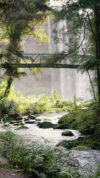Lesen Sie unsere Paper und Poster
Hier können Sie weitere wissenschaftliche Veröffentlichungen herunterladen
Sur, Herrmann (2022) Determination of transfer factors for solute concentrations from agricultural fields to drinking water abstraction points
The stepwise attenuation of solute concentrations has been determined, starting from the unsaturated zone underneath treated fields across the deeper aquifer, down to drinking water abstraction wells. The partial or overall transfer or attenuation factor may help to make informed decisions on the magnitude of the decrease in concentrations from shallow leachate to drinking water abstraction, which is largely caused by mixing.
Faupel et al. (2022) Precision farming and environmental pesticide regulation in the EU—How does it fit together?
Precision farming technology allows pesticides to be applied precisely to the target while leaving the rest of the field untreated. In the regulation of pesticides, however, a homogeneously sprayed field is considered as the standard scenario.
Herrmann, Sur (2021) Natural attenuation along subsurface flow paths based on modeling and monitoring of a pesticide metabolite from three case studies
Groundwater—especially for the use as drinking water—is a strictly protected resource in the existing guidelines for pesticide registration and drinking water protection in the EU.
Franke et al. (2021) Results of 2‐Year Ring Testing of a Semifield Study Design to Investigate Potential Impacts of Plant Protection Products on the Solitary Bees Osmia Bicornis and Osmia Cornuta and a Proposal for a Suitable Test Design
There are various differences in size, behavior, and life history traits of non‐Apis bee species compared with honey bees (Apis mellifera; Linnaeus, 1758). Currently, the risk assessment for bees in the international and national process of authorizing plant protection products has been based on honey bee data as a surrogate organism for non‐ Apis bees.
Lückmann, Kaiser, Blankenhagen (2020) Precision farming – consideration of reduced exposure in the pollinator risk assessment
Observed declines in the distribution and abundance of various insect species have moved the topic of biodiversity and the protection of honey bees, an insect species of particular economic interest, into the focus of public attention. This also resulted in an increasing public pressure to reform the European agricultural policy and as part of this to minimise the amount of synthetic plant protection products used.
Mair et al. (2020) The Minimum Detectable Difference (MDD) Concept for Establishing Trust in Nonsignificant Results: A Critical Review
Current regulatory guidelines for pesticide risk assessment recommend that nonsignificant results should be complemented by the minimum detectable difference (MDD), a statistical indicator that is used to decide whether the experiment could have detected biologically relevant effects.
Schabacker et al. (2020) Residue Levels of Pesticides on Fruits for Use in Wildlife Risk Assessments
The guidance document on risk assessment for birds and mammals (GD) provides generic residue values of pesticides on potential diet items for use in wildlife risk assessments. For most diet items, these values are based on a large number of residue studies.
Schimera et al. (2020) Consideration of nectarivorous birds in wildlife risk assessments
In subtropical and tropical climate zones where crops exhibit a flowering phase before harvest, nectar-feeding birds (see table) may be attracted to crop flower nectar. We present points to consider on whether and how a nectarivorous avian scenario might be included in higher tier environmental risk assessment (ERA) for plant protection products (PPPs) and what data would be needed.
Klopper et al. (2020) How to reduce computation effort for GUTS modelling while retaining output reliability for risk assessment use?
The practicability of approaches can influence their usability in environmental risk assessment (ERA). The anticipated 20- year data in aquatic RA would considerably amplify computational effort and therefore pose a challenge for General Unified Threshold Model of Survival (GUTS) applications in ERA.
Lückmann et al. (2020) Precision pesticide application as a tool to reduced exposure of crop visiting pollinators?
Recent publications on severe declines of insects moved the topic of biodiversity in agricultural landscapes into the focus of public attention. Consequently, European policy is under increasing public pressure to minimize the amount of synthetic pesticides applied and to reform the criteria for their authorization and use.
Ludwigs et al. (2019) Response to David R. Crocker and Steven D. Langton “When Is It Legitimate to Downplay Individual Differences?”
In their letter, Crocker and Langton (2019) critically discuss the approach of 21‐dMonte Carlo PT (portion of diet from a pesticidetreated area) simulations proposed in Ludwigs et al. (2017). The aim of this method is to assess realistic 21‐d PT values by including daily variability in habitat use for individual animals.
Grimm et al. (2019) Bats, birds & shrews in environmental risk assessment
Bats are not specifically considered in pesticide risk assessments. The implicit assumption is that bats are covered by the current avian or mammalian risk assessment scheme according to EFSA (2009) which focusses on birds and mammals, such as rodents, shrews and lagomorphs.


